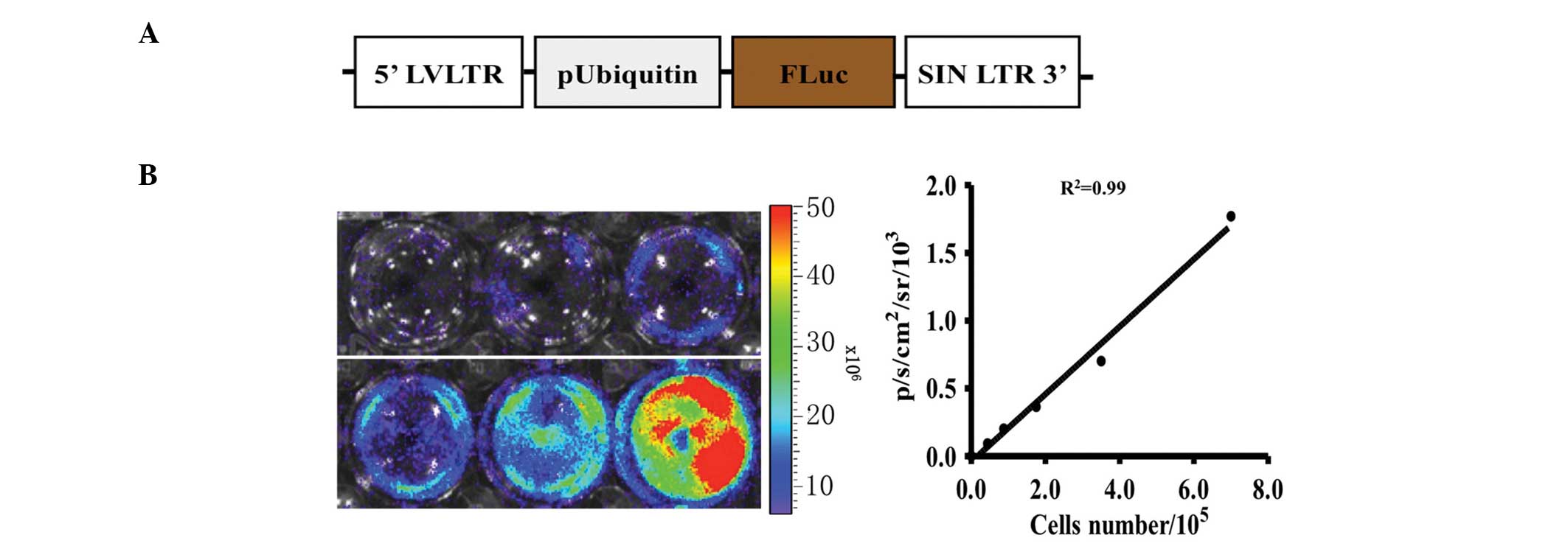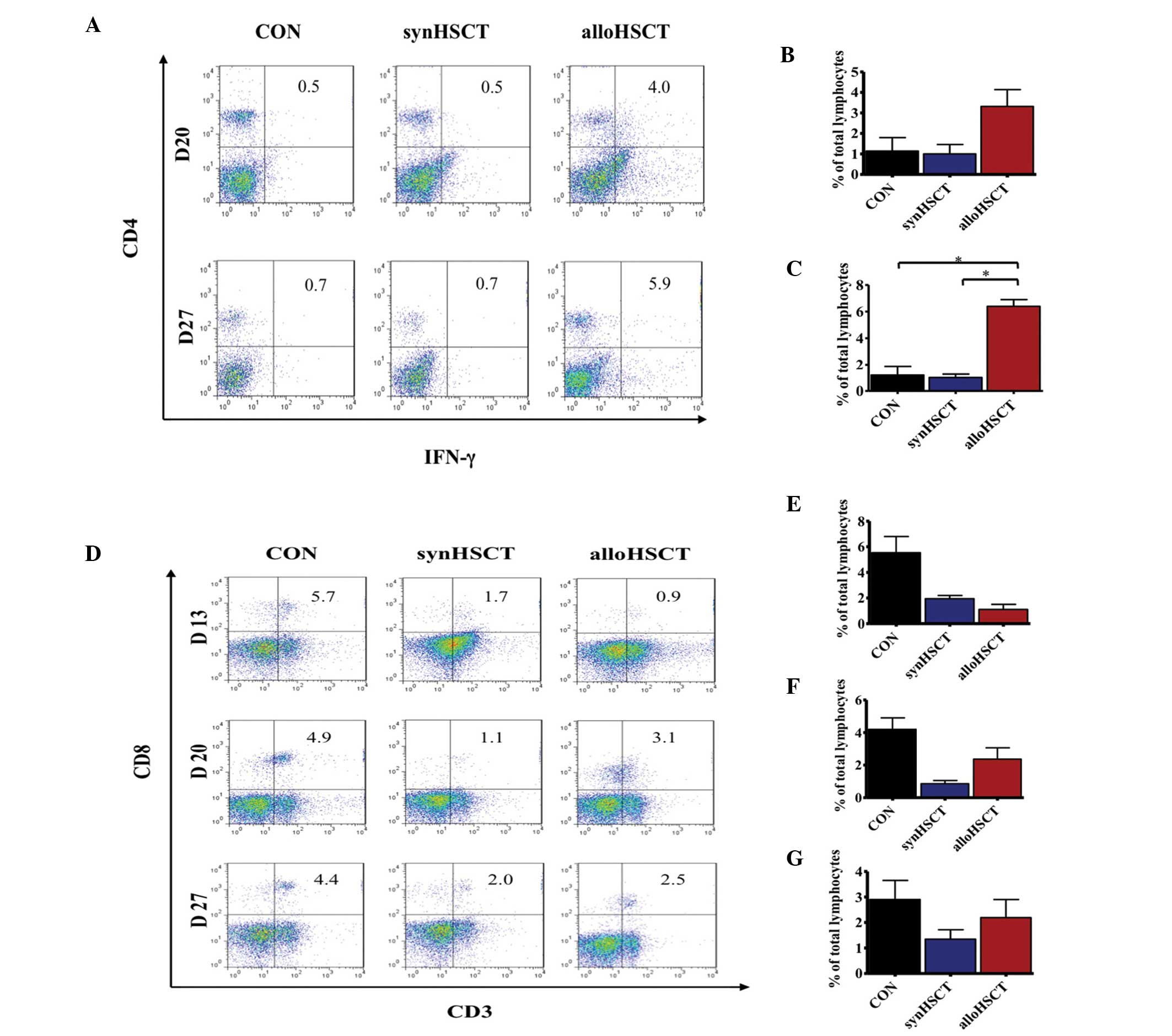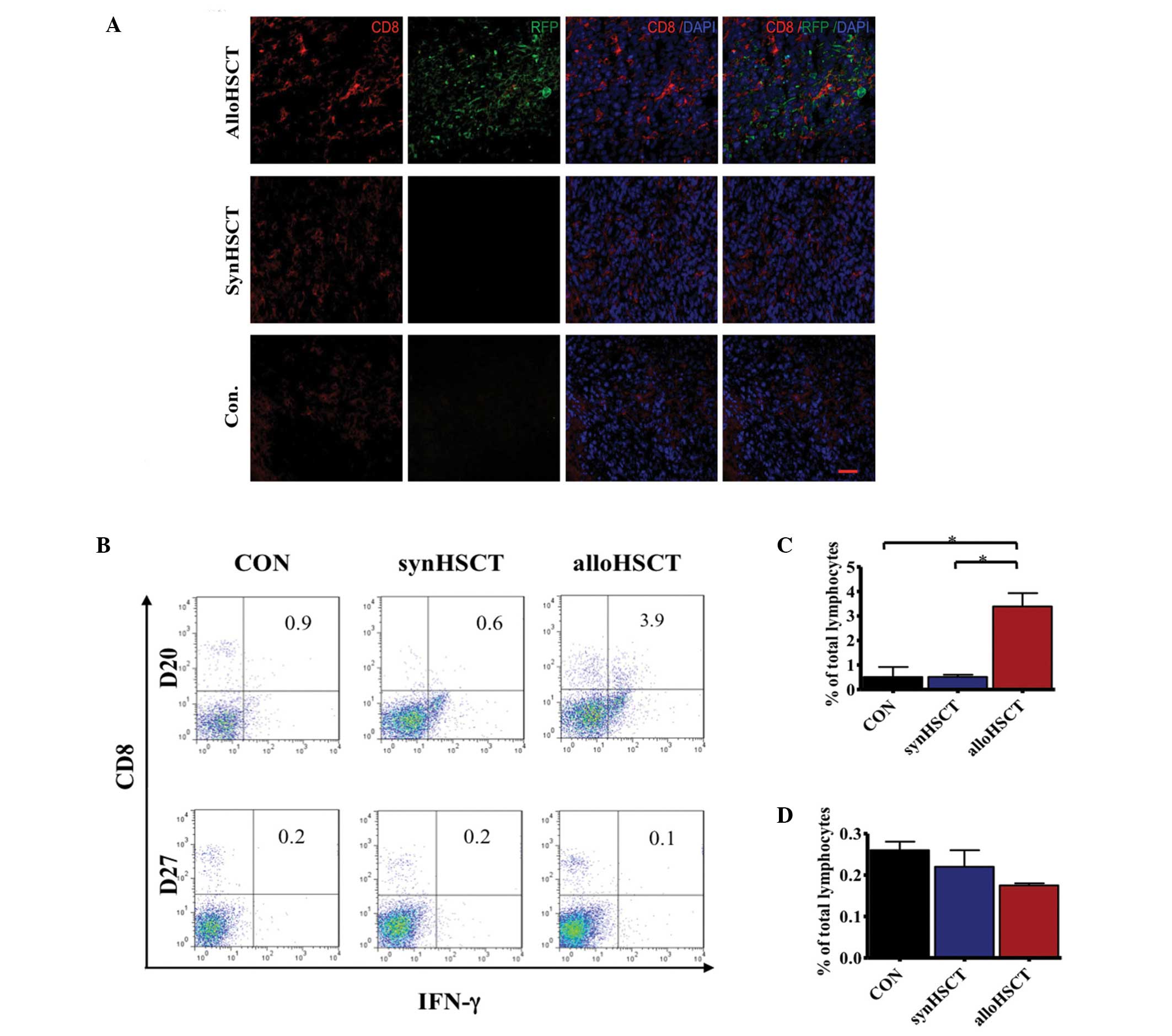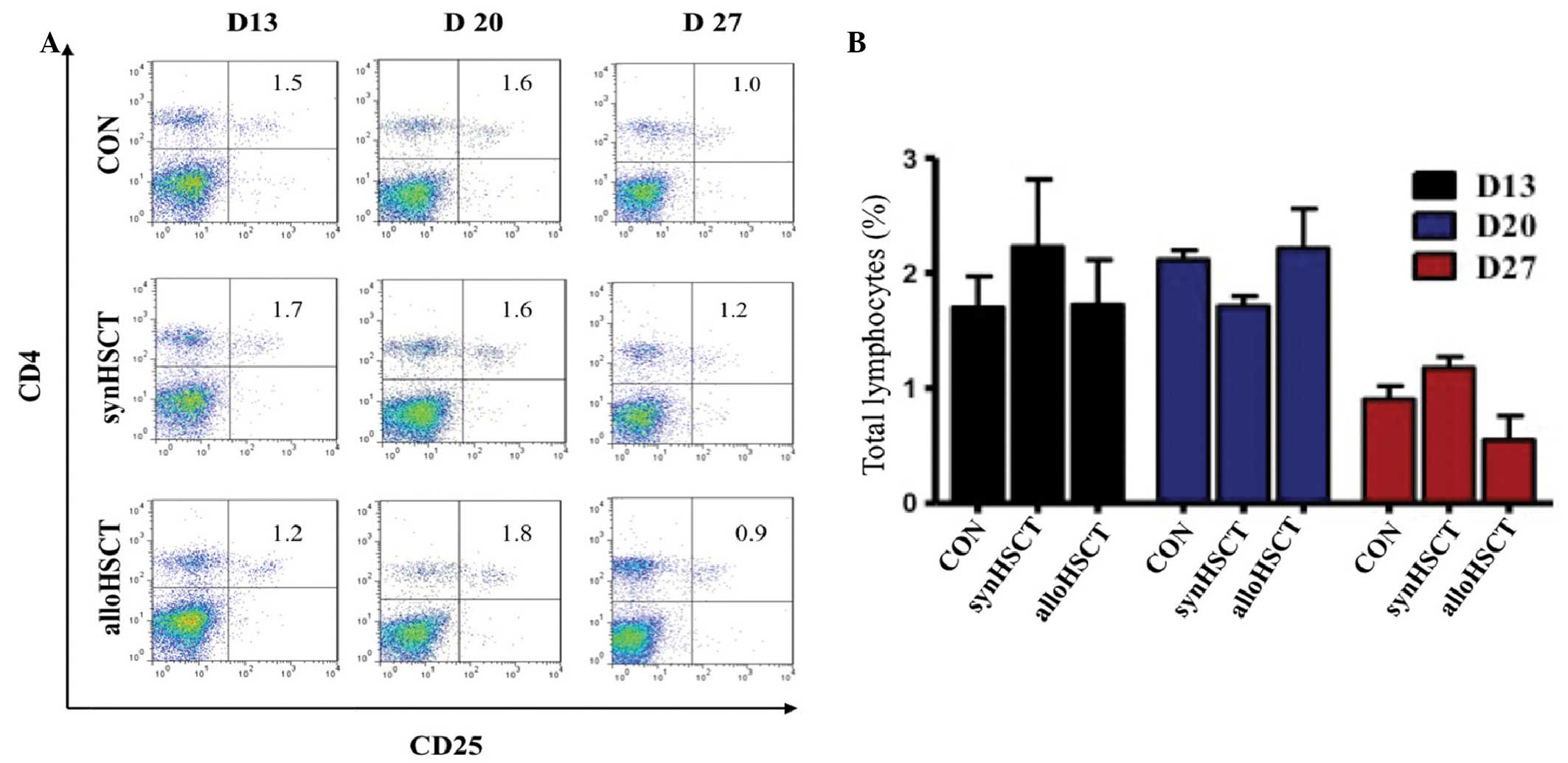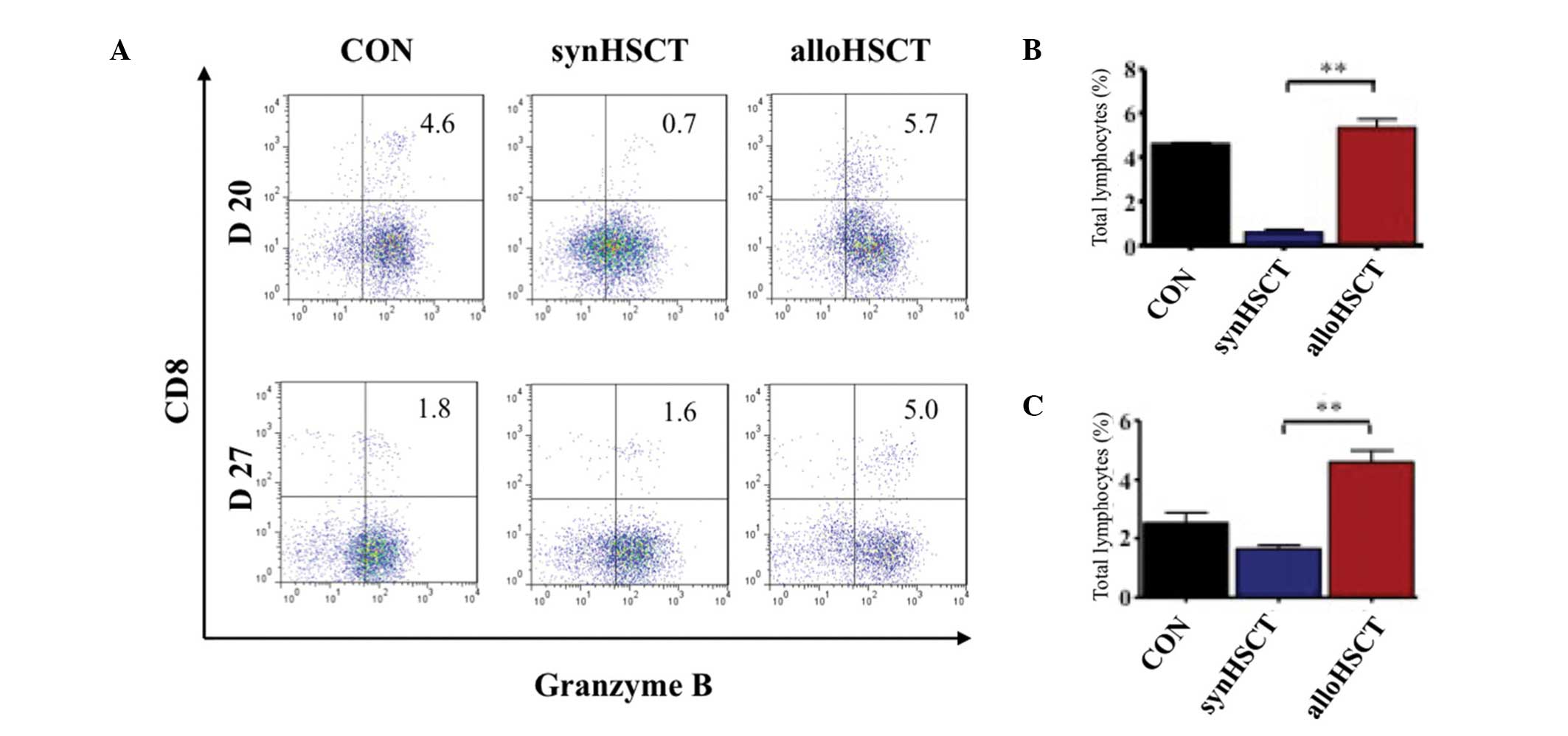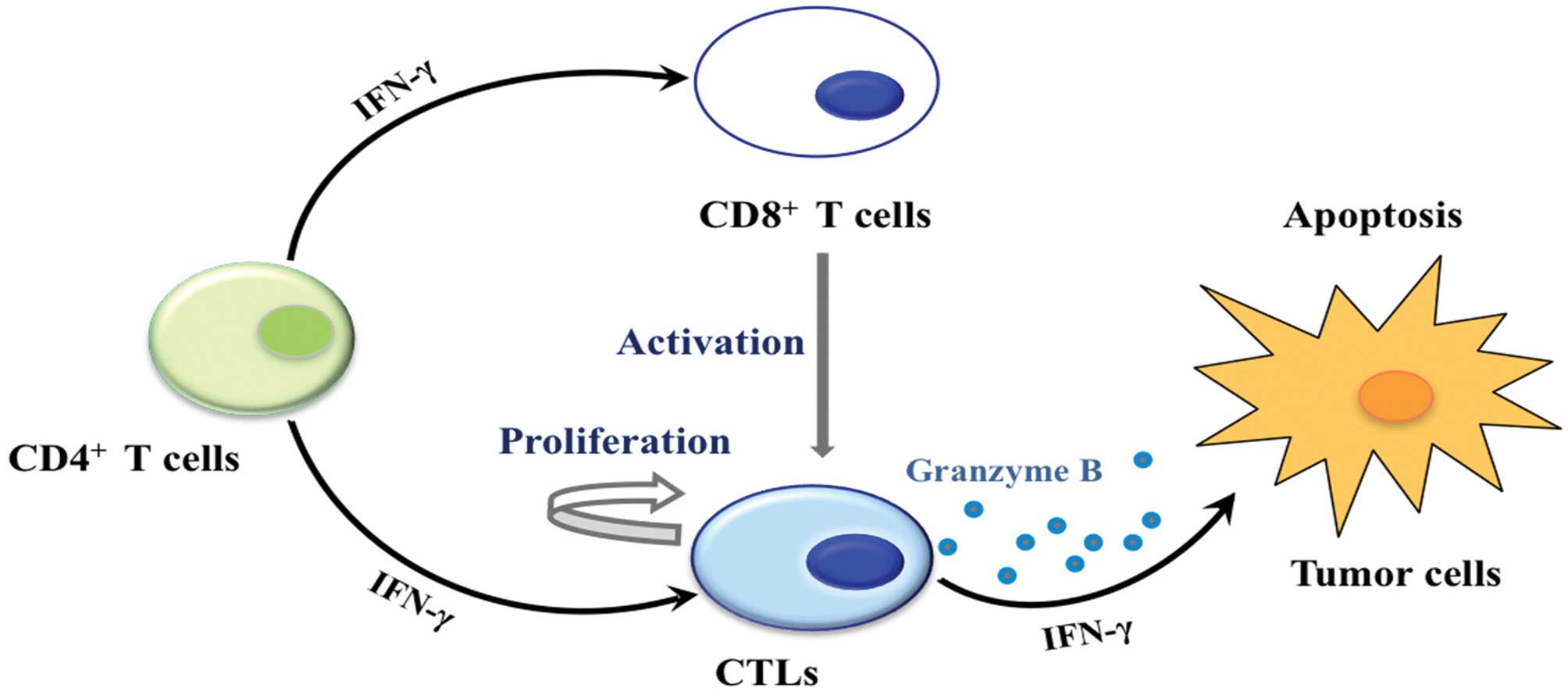Introduction
Graft-versus-host disease (GVHD), also known as
graft-versus-tumor (GVT) effects, has been demonstrated to enhance
the therapeutic effect of allogeneic hematopoietic stem cell
transplantation (HSCT) in the treatment of leukemia (1). The GVT effects may also observed in
patients with solid tumors, including breast, renal and colorectal
cancer, treated with allogeneic transplantation (2). The major GVT effectors are cytotoxic
T lymphocytes (CTLs), which recognize allogeneic histocompatibility
antigens and unique tumor antigens (1). In addition, accumulating evidence
indicates that interferon (IFN)-γ exerts a protective effect
against GVHD, whilst also participating in the GVT reaction
(3,4).
Cellular and molecular mechanisms underlying the GVT
effects remain poorly understood. However, it is hypothesized that
donor CTLs exhibit a cytotoxic effect against minor
histocompatibility antigens or tumor-associated antigens. In
addition, regulatory T cells (Tregs) have been demonstrated to
protect the host from GVHD by suppressing donor immune cells, and
may also block antitumor immune responses (5). IFN-γ has been found to sensitize
tumor cells to CTLs, thus, inhibiting the expansion of tumor cells
and upregulating the expression of Fas and major histocompatibility
complex (MHC) molecules (6).
Furthermore, IFN-γ has been hypothesized to function directly on
CD8+ T cells to stimulate the development of the CTL
response (7,8). However, the role of IFN-γ in
graft-versus-solid tumor effects remains unclear.
In present study, the mechanisms underlying the
immune antitumor reactivity of allogeneic HSCT and the regulation
of alloreactive CTLs and Tregs by IFN-γ were investigated. The
secretion of IFN-γ, as well as the expansion and cytotoxicity of
CTLs, were hypothesized to enhance following allogeneic HSCT; thus,
IFN-γ may promote GVT effects by enhancing CTL proliferation and
cytotoxicity.
Material and methods
Tumor models
Animal studies were performed in accordance with the
guidelines from the Nankai University Animal Care and Use Committee
(Tianjin, China) and conformed to the National Institutes of Health
Guide for Care and Use of Laboratory Animals. Mice (9–12 weeks old,
n=18) were purchased from the Experimental Animal Institute of the
Chinese Academy of Medical Sciences (Beijing, China) and were
housed under standard laboratory conditions. The breast cancer cell
line, 4T1 (American Type Culture Collection, Rockville, MD, USA),
was transfected with the firefly luciferase (Fluc) reporter gene,
and 5×104 4T1-Fluc cells were in situ injected
into the mammary fat pads of 9–12 week-old female BALB/c mice.
HSCT
BALB/c mice recipients were administered autoclaved
and acidified water containing antibiotics (30 μg/ml fluconazole
and 100 μg /ml norfloxacin; Pfizer, New York, NY, USA) at day 5
prior to and at week 2 following irradiation. HSCT was performed as
previously described (9,10). Briefly, at day 6 following the 4T1
cell challenge, mice were irradiated with 9.5-Gy whole-body
γ-irradiation in two divided doses that were 2 h apart. For HSCT,
the BALB/c mice were injected with 0.2 ml phosphate-buffered saline
containing 2.0×105 bone marrow mononuclear cells from
female red fluorescent protein (RFP) transgenic C57BL/6-RFP
(H-2b), C57BL/6 or BALB/c mice via a tail vein injection
within 2 h after irradiation.
Bioluminescence imaging (BLI)
BLI of tumor progression in the living mice was
performed as previously described (11,12).
Briefly, mice underwent BLI to assess Fluc expression using an
in vivo Imaging System (IVIS 200; Xenogen Corporation,
Hopkinto, MA, USA). Following anesthesia with 2% isoflurane, mice
were intraperitoneally injected with 150 mg/kg D-luciferin
(Biosynth International, Naperville, IL, USA), and underwent 1 sec
to 5 min scans to analyze Fluc expression. The bioluminescence
signals were quantified using Living Image Software (Xenogen
Corporation).
Flow cytometric analysis
Fluorescence-activated cell sorting (FACS) analysis
of splenocytes was performed using phycoerythrin- or
allophycocyanin-conjugated antibodies against mouse CD3 (BD
Pharmingen, San Diego, CA, USA), CD8 (eBioscience, San Diego, CA,
USA), CD4 (BD Pharmingen), CD25 (BD Pharmingen), IFN-γ (BD
Pharmingen) and granzyme B (eBioscience). Cells were labeled in
accordance with the manufacturer’s instructions and were analyzed
on a FACS Calibur (BD Biosciences, Heidelberg, Germany) using
CellQuest software (BD Biosciences).
Immunofluorescence staining
Tumors were isolated at the end of the imaging
studies and sectioned for immunofluorescence staining. Briefly,
frozen sections were fixed with 4% paraformaldehyde and incubated
with anti-CD8 (BD Pharmingen) or anti-RFP antibodies (Invitrogen
Life Technologies, Carlsbad, CA, USA) overnight at 4°C. The
sections were washed and incubated with secondary antibodies at
room temperature for 30 min, and the cell nuclei were then
counterstained with 4,6-diamidino-2-phenylindole (BD Pharmingen).
The sections were observed and imaged using a fluorescence
microscope (Olympus Corporation, Tokyo, Japan).
Statistical analysis
Statistics were calculated using SPSS software,
version 16.0 (SPSS, Inc., Chicago, IL, USA). Data are expressed as
the mean ± standard error of the mean. The statistical significance
of intergroup differences of the mean values were analyzed using
one-way analysis of variance with Bonferroni’s test. P<0.05 was
considered to indicate a statistically significant difference.
Results
Labeling 4T1 cells with the Fluc reporter
gene
An imaging platform for tracking 4T1 cells in mice
was developed using the Fluc reporter gene (Fig. 1A). Following culture in 24-well
plates, a strong correlation (r2=0.99) was observed
between the Fluc signal intensity and the cell number ex
vivo (Fig. 1B).
HSCT significantly suppresses tumor
growth
To investigate the potential GVT effects of
allogeneic HSCT, an in situ breast cancer model in BALB/c
mice was used. Following total body irradiation with 9.5 Gy on day
6, bone marrow mononuclear cells from allogeneic C57BL/6 or
syngeneic BALB/c donors were transplanted into BALB/c mice
(Fig. 2A). The development of
tumors was analyzed using BLI of Fluc. The average Fluc signal
intensity increased rapidly in the control group that did not
receive treatment (Fig. 2B and C).
By contrast, the Fluc signal in the allogeneic HSCT group increased
slightly and statistically significant differences were observed
between the two groups (P<0.05 on day 27; P<0.01 on day 20).
Immunofluorescence staining of RFP in the tumor tissues
demonstrated that there were a large number of infiltrated tumor
cells, which were derived from the donor bone marrow hematopoietic
stem cells following allogeneic HSCT (Fig. 2D).
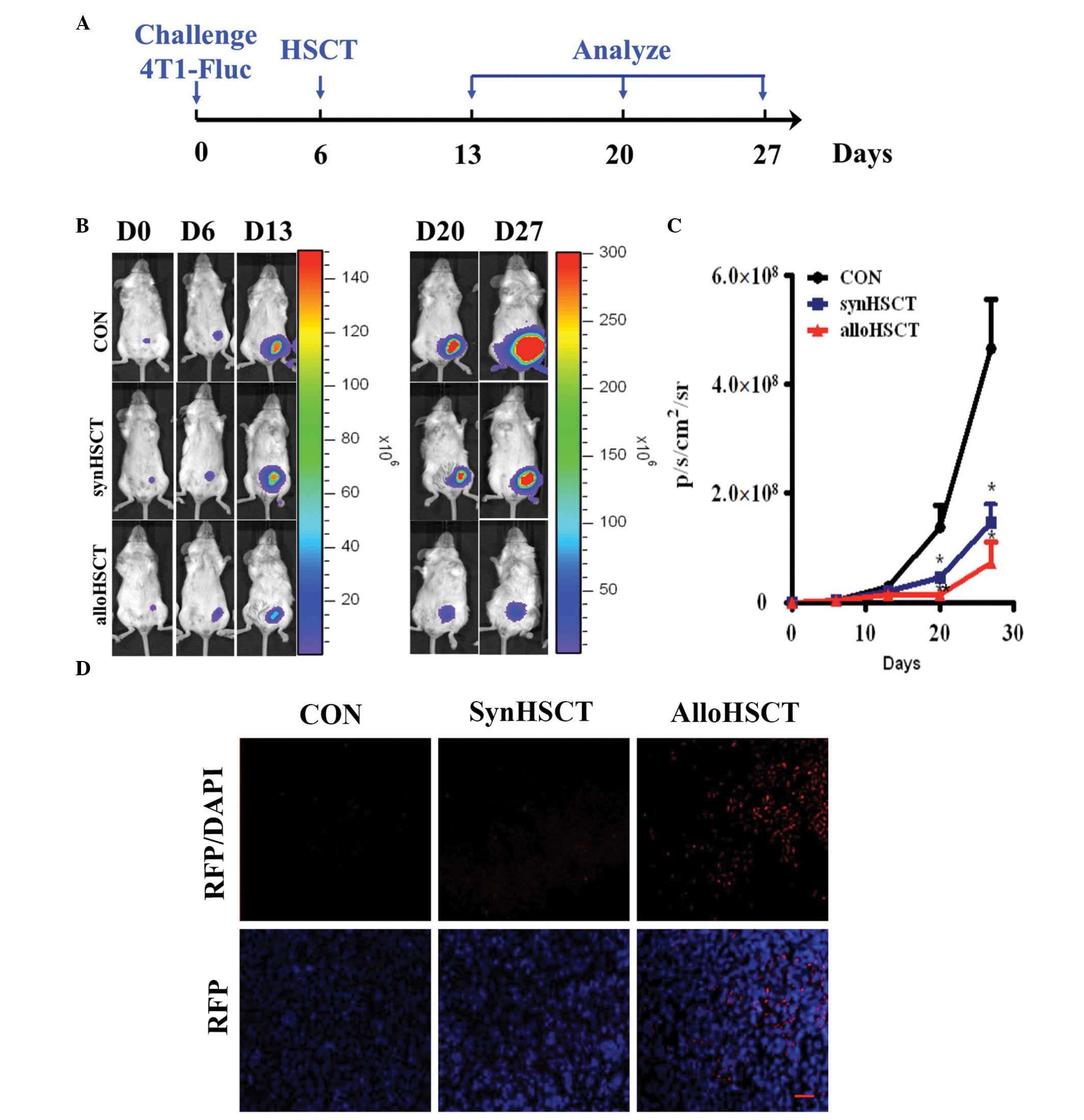 | Figure 2Allogeneic HSCT significantly
suppressed the growth of breast cancer tumors. (A) Mouse model and
treatment schedule of HSCT. (B) BLI of representative mice from
each group are shown following 4T1-Fluc cell inoculation. (C)
Quantitative analysis of the BLI signal intensity in each group.
Bioluminescence activity is shown as photons/sec/cm2/sr
and results are expressed as the mean ± standard error of the mean
(≥5 mice per group). *P<0.05 and
**P<0.01, vs. control. (D) Breast cancer tissues from
the BALB/c mice in the Con, SynHSCT and AlloHSCT groups were
obtained and stained for RFP on day 35. The nuclei were
counterstained with 4,6-diamidino-2-phenylindole (scale bar = 50
μm). HSTC, hematopoietic stem cell transplantation; Con, control
group; SynHSCT, syngeneic HSCT group; alloHSCT, allogeneic HSCT
group; RFP, red fluorescent protein; BLI, bioluminescence imaging;
Fluc, firefly luciferase. |
IFN-γ, secreted by T lymphocytes,
mediates antitumor effects
IFN-γ has been previously shown to be involved in
allogeneic GVT effects and the inhibition of GVHD (13). To elucidate the mechanism of GVT,
splenic lymphocytes were intracellularly stained for IFN-γ and
analyzed using flow cytometry (Fig.
3). Following allogeneic HSCT, the production of IFN-γ in
CD4+ lymphocytes was significantly increased compared
with the control and syngeneic HSCT groups on day 20 and 27
(Fig. 3B and C).
In addition, CTLs have been previously demonstrated
to play an important role in the GVT effects (14), and were shown to be regulated by
CD4+ T helper cells secreting IFN-γ. To determine
whether the proliferation of CTLs following allogeneic HSCT is
different compared with syngeneic HSCT in breast cancer animal
models, CD3+CD8+ CTLs were analyzed by flow
cytometry (Fig. 3D). On days 13,
20 and 27, the mice were euthanized by intrapertioneal injection of
4% chloral hydrate and single cell suspensions of splenic
lymphocytes were obtained. Flow cytometric analysis revealed that
the number of CTLs following allogeneic HSCT was higher compared
with syngeneic HSCT on days 20 and 27 (Fig. 3E–G), indicating that despite the
number of CTLs following transplantation not completely recovering
to a normal level, the IFN-γ secreted by T lymphocytes following
allogeneic HSCT may promote the expansion of CTLs and exert a
suppressive effect on cancer. To further investigate the long-term
GVT effects mediated by CTLs, tumor tissues were isolated at day 40
following tumor cell inoculation. CD8 expression in the tumor
tissues was found to be significantly enhanced in the allogeneic
HSCT group compared with the syngeneic HSCT group (Fig. 4A).
Furthermore, IFN-γ expression levels in
CD8+ lymphocytes (Fig.
4B) increased on day 20, returning to the basal level by day
27, in mice treated with allogeneic transplantation (Fig. 4C and D). These results provide
novel insights into the role of IFN-γ in regulating GVT-associated
alloreactivity of allogeneic HSCT.
Proliferation of Tregs is suppressed
following allogeneic HSCT
To examine the effect of allogeneic HSCT on Tregs,
splenic lymphocytes were isolated from mice treated with allogeneic
or syngeneic HSCT, and the levels of
CD4+CD25+ Tregs were analyzed (Fig. 5A). No significant differences were
observed among the levels of Tregs in the control, syngeneic HSCT
and allogeneic HSCT groups on days 13, 20 and 27 (Fig. 5B), indicating that the GVT effects
may be mediated by enhancing CTL activity, as opposed to
suppressing Tregs.
CTLs produce granzyme B and exert
antitumor activity following allogeneic HSCT
To verify the mechanism of CTL-mediated cytotoxicity
and apoptosis, splenic lymphocytes were analyzed using
intracellular staining of granzyme B. CD8+ T lymphocytes
were shown to produce granzyme B (Fig.
6A). Furthermore, the number of granzyme B+ CTLs
following allogeneic HSCT was greater compared with syngeneic HSCT,
with statistically significant differences (P<0.01) observed on
days 20 and 27 (Fig. 6B and C,
respectively). Thus, the results indicated that CTLs secrete
granzyme B and may mediate the apoptosis of target cells following
allogeneic HSCT.
Considering the significant inhibition of tumors
following allogeneic HSCT, GVT was found to be mediated by donor
CTL cytotoxicity via IFN-γ and granzyme B. Furthermore, the
activation and proliferation of CTLs was enhanced by IFN-γ, which
was secreted by CD4+ T cells (Fig. 7).
Discussion
In the present study, the immune mechanism of GVT
activity in allogenenic HSCT was investigated. The allograft was
demonstrated to confer significant GVT activity against breast
cancer. Furthermore, the results revealed that GVT effects are
dependent on the IFN-γ and granzyme B signaling pathways.
Allotransfer was demonstrated to mediate the expansion of CTLs,
resulting in higher levels of granzyme B. In addition, the
expansion of Tregs, which is associated with tumor progression, was
significantly suppressed at the later stages following allogeneic
transplantation. Therefore, these observations indicate that
alloreactive CD4+ and CD8+ T cells produce
IFN-γ, which regulates the alloresponse of donor CTL cells,
resulting in cytotoxic effects by CTLs on tumor cells.
IFN-γ produced by donor T cells has an important
role in the induction of the CD8+ T cell-mediated GVT
reaction, which results in tumor delay or even tumor rejection in
the absence of lethal GVHD (15).
The ability of IFN-γ to inhibit the growth of tumor cells (16,17),
including breast cancer cells (18), has been demonstrated in several
studies. In breast cancer patients with skin metastasis, in
situ injection of IFN-γ resulted in total or partial regression
of the skin lesions (19). A
number of studies have hypothesized that IFN-γ exerts its antitumor
effects by regulating several aspects of innate and adaptive
immunity, including activating CTLs and natural killer cells and
inhibiting the generation of CD4+CD25+ Tregs
(6,20,21).
The results of the present study revealed that the expansion or
activation/proliferation of CTLs was slightly increased following
allogeneic transplantation, as compared with syngeneic transfer,
and allogeneic transplantation suppressed the expansion of Tregs at
a later stage. CTLs have been shown to be associated with a
positive outcome (improved effect on suppression of tumor growth
than that of Tregs) (22), whilst
immunosuppressive Tregs are associated with tumor progression and
poor prognosis (23); thus, the
response to allotransfer therapy correlates with inverse changes in
the numbers of CTLs and Tregs.
Despite CTLs exerting an efficient tumor rejection
effect following allogeneic transplantation, the proportion of CTLs
was lower in mice treated with HSCT compared with mice that
received no treatment. Thus, the regulation of T cells by IFN-γ
alone may be insufficient to explain the GVT effects of allogeneic
HSCT, and other mechanisms may be involved. IFN-γ signaling in
tumor cells inhibits cancer cell expansion by inducing apoptosis
and suppressing proliferation, and may also increase the
sensitivity of tumor cells to the cytolytic activity of
alloreactive CTLs via the upregulation of MHC class I and Fas
molecules (24). The results of
the present study revealed high levels of granzyme B production by
CD8+ CTLs. Granzyme B is known to be delivered by
perforin into target tumor cells, where it induces apoptosis by
cleaving critical substrates (25). The execution of apoptosis by
granzyme B usually occurs via the activation of the caspase family
of cysteine proteases, which are central regulators of the
apoptotic pathway for multiple inducers of cell death (26). Contact-dependent lysis is also
critical for alloreactive CTLs to mediate GVT effects in allogeneic
HSCT recipients.
The majority of target antigens for the GVT effects
have yet to be identified, but include unique tumor antigens and
host alloantigens. Allogeneic immunotherapy for cancer is
restricted by suboptimal GVT effects and GVHD associated with GVT
effects. Previous studies have demonstrated that GVT effects and
GVHD may be separated by IFN-γ in hematopathy and solid tumor
disease animal models (4,27). GVHD- and GVT-associated
alloresponses of CD8+ T cells may be dissociated by an
IFN-γ-dependent mechanism, whereby CD8+ T cells from
IFN-γ receptor-deficient donor mice induced more severe GVHD in
allogeneic recipients compared with transfer cells from wild-type
donors.
In conclusion, alloreactive T cells produce IFN-γ,
which promotes the alloresponses of donor CTLs. In addition,
granzyme B, produced by CTLs, exerts a tumor suppressive effect.
Exploitation of these immunotherapy mechanisms may improve the
outcome of clinical bone marrow transplants and lead to the
development of novel treatments for breast cancer, as well as other
solid tumors.
Acknowledgements
The study was partially supported by grants from the
National Basic Research Program of China (no. 2011CB964903 and
2013CB967201), the Program for New Century Excellent Talents in
University (no. NCET-12-0282), the National Natural Science
Foundation of China (no. 81371620) and the Tianjin Natural Science
Foundation (no. 12JCZDJC24900).
References
|
1
|
Blazar BR, Murphy WJ and Abedi M: Advances
in graft-versus-host disease biology and therapy. Nat Rev Immunol.
12:443–458. 2012. View
Article : Google Scholar : PubMed/NCBI
|
|
2
|
Kamiryo Y, Eto M, Yamada H, et al: Donor
CD4 T cells are critical in allogeneic stem cell transplantation
against murine solid tumor. Cancer Res. 69:5151–5158. 2009.
View Article : Google Scholar : PubMed/NCBI
|
|
3
|
Wang H, Asavaroengchai W, Yeap BY, et al:
Paradoxical effects of IFN-gamma in graft-versus-host disease
reflect promotion of lymphohematopoietic graft-versus-host
reactions and inhibition of epithelial tissue injury. Blood.
113:3612–3619. 2009. View Article : Google Scholar : PubMed/NCBI
|
|
4
|
Yang Y, Wang H, Yu H, et al: IFN-γ
promotes graft-versus-leukemia effects without directly interacting
with leukemia cells in mice after allogeneic hematopoietic cell
transplantation. Blood. 118:3721–3724. 2011.
|
|
5
|
Taylor PA, Lees CJ and Blazar BR: The
infusion of ex vivo activated and expanded CD4(+)CD25(+) immune
regulatory cells inhibits graft-versus-host disease lethality.
Blood. 99:3493–3499. 2002.
|
|
6
|
Ikeda H, Old LJ and Schreiber RD: The
roles of IFN gamma in protection against tumor development and
cancer immunoediting. Cytokine Growth Factor Rev. 13:95–109. 2002.
View Article : Google Scholar : PubMed/NCBI
|
|
7
|
Pratheeshkumar P and Kuttan G: Modulation
of cytotoxic T lymphocyte, natural killer cell, antibody-dependent
cellular cytotoxicity, and antibody-dependent complement-mediated
cytotoxicity by Vernonia cinerea L. and vernolide-A in
BALB/c mice via enhanced production of cytokines IL-2 and IFN-γ.
Immunopharmacol Immunotoxicol. 34:46–55. 2012. View Article : Google Scholar : PubMed/NCBI
|
|
8
|
Moreno M, Molling JW, von
Mensdorff-Pouilly S, et al: IFN-gamma-producing human invariant NKT
cells promote tumor-associated antigen-specific cytotoxic T cell
responses. J Immunol. 181:2446–2454. 2008. View Article : Google Scholar : PubMed/NCBI
|
|
9
|
Feng G, Mao D, Che Y, et al: The
phenotypic fate of bone marrow-derived stem cells in acute kidney
injury. Cell Physiol Biochem. 32:1517–1527. 2013. View Article : Google Scholar : PubMed/NCBI
|
|
10
|
Jia X, Xie X, Feng G, et al: Bone
marrow-derived cells can acquire renal stem cells properties and
ameliorate ischemia-reperfusion induced acute renal injury. BMC
Nephrol. 13:1052012. View Article : Google Scholar : PubMed/NCBI
|
|
11
|
Zhou M, Wang L, Su W, et al: Assessment of
therapeutic efficacy of liposomal nanoparticles mediated gene
delivery by molecular imaging for cancer therapy. J Biomed
Nanotechnol. 8:742–750. 2012. View Article : Google Scholar : PubMed/NCBI
|
|
12
|
Su W, Wang L, Zhou M, et al: Human
embryonic stem cell-derived endothelial cells as cellular delivery
vehicles for treatment of metastatic breast cancer. Cell
Transplant. 22:2079–2090. 2013. View Article : Google Scholar : PubMed/NCBI
|
|
13
|
Yang YG, Qi J, Wang MG and Sykes M:
Donor-derived interferon gamma separates graft-versus-leukemia
effects and graft-versus-host disease induced by donor CD8 T cells.
Blood. 99:4207–4215. 2002. View Article : Google Scholar : PubMed/NCBI
|
|
14
|
Bishop MR: Nonmyeloablative allogeneic
hematopoietic stem cell transplantation for metastatic breast
cancer. Clin Breast Cancer. 4:39–45. 2003. View Article : Google Scholar : PubMed/NCBI
|
|
15
|
Asavaroengchai W, Wang H, Wang S, et al:
An essential role for IFN-gamma in regulation of alloreactive CD8 T
cells following allogeneic hematopoietic cell transplantation. Biol
Blood Marrow Transplant. 13:46–55. 2007. View Article : Google Scholar : PubMed/NCBI
|
|
16
|
Seki N, Brooks AD, Carter CR, et al:
Tumor-specific CTL kill murine renal cancer cells using both
perforin and Fas ligand-mediated lysis in vitro, but cause tumor
regression in vivo in the absence of perforin. J Immunol.
168:3484–3492. 2002. View Article : Google Scholar
|
|
17
|
Connett JM, Hunt SR, Hickerson SM, Wu SJ
and Doherty GM: Localization of IFN-gamma-activated Stat1 and IFN
regulatory factors 1 and 2 in breast cancer cells. J Interferon
Cytokine Res. 23:621–630. 2003. View Article : Google Scholar : PubMed/NCBI
|
|
18
|
Yim JH, Ro SH, Lowney JK, Wu SJ, Connett J
and Doherty GM: The role of interferon regulatory factor-1 and
interferon regulatory factor-2 in IFN-gamma growth inhibition of
human breast carcinoma cell lines. J Interferon Cytokine Res.
23:501–511. 2003. View Article : Google Scholar : PubMed/NCBI
|
|
19
|
Gage I, Schnitt SJ, Recht A, et al: Skin
recurrences after breast-conserving therapy for early-stage breast
cancer. J Clin Oncol. 16:480–486. 1998.PubMed/NCBI
|
|
20
|
Chen C, Guo L, Shi M, et al: Modulation of
IFN-gamma receptor 1 expression by AP-2α influences IFN-γ
sensitivity of cancer cells. Am J Pathol. 180:661–671.
2012.PubMed/NCBI
|
|
21
|
Nishikawa H, Kato T, Tawara I, et al:
IFN-gamma controls the generation/activation of CD4+ CD25+
regulatory T cells in antitumor immune response. J Immunol.
175:4433–4440. 2005.PubMed/NCBI
|
|
22
|
Gillmore R, Xue SA, Holler A, et al:
Detection of Wilms’ tumor antigen - specific CTL in tumor-draining
lymph nodes of patients with early breast cancer. Clin Cancer Res.
12:34–42. 2006.
|
|
23
|
Chen L, Huang TG, Meseck M, Mandeli J,
Fallon J and Woo SL: Rejection of metastatic 4T1 breast cancer by
attenuation of Treg cells in combination with immune stimulation.
Mol Ther. 15:2194–2202. 2007. View Article : Google Scholar : PubMed/NCBI
|
|
24
|
Duncan TJ, Rolland P, Deen S, et al: Loss
of IFN gamma receptor is an independent prognostic factor in
ovarian cancer. Clin Cancer Res. 13:4139–4145. 2007. View Article : Google Scholar : PubMed/NCBI
|
|
25
|
Fan Z and Zhang Q: Molecular mechanisms of
lymphocyte-mediated cytotoxicity. Cell Mol Immunol. 2:259–264.
2005.PubMed/NCBI
|
|
26
|
Los M, Wesselborg S and Schulze-Osthoff K:
The role of caspases in development, immunity, and apoptotic signal
transduction: lessons from knockout mice. Immunity. 10:629–639.
1999. View Article : Google Scholar : PubMed/NCBI
|
|
27
|
Ramirez-Montagut T, Chow A, Kochman AA, et
al: IFN-gamma and Fas ligand are required for graft-versus-tumor
activity against renal cell carcinoma in the absence of lethal
graft-versus-host disease. J Immunol. 179:1669–1680. 2007.
View Article : Google Scholar : PubMed/NCBI
|















